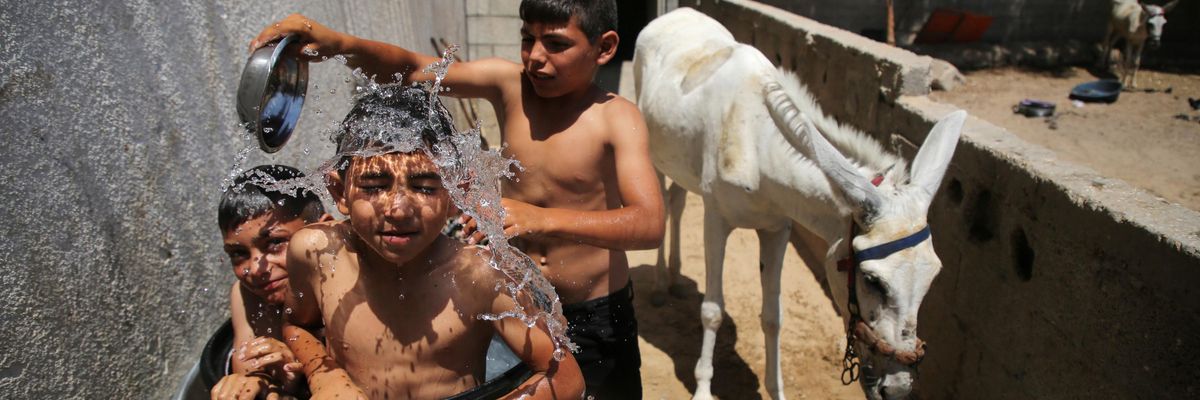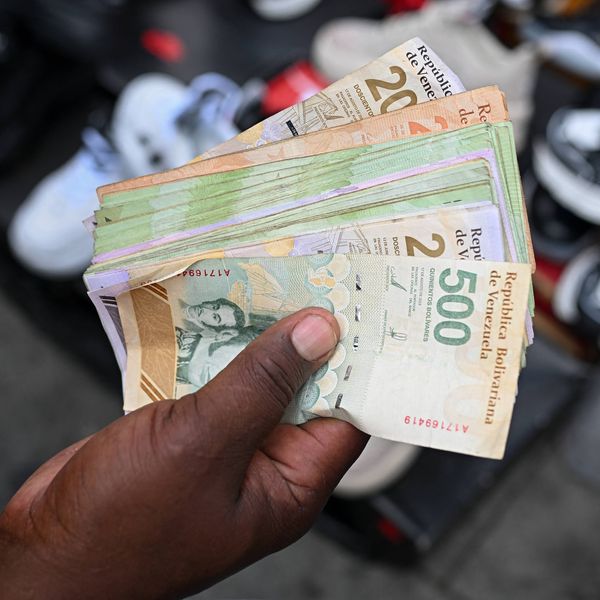
Palestinian children shower to cool off on a hot summer day in Beit Lahia, in the northern Gaza Strip, on July 21, 2022. (Photo: Majdi Fathi/NurPhoto via Getty Images)
2 Billion Kids to Face Extreme Heatwave Threat by 2050, Warns UNICEF
"The dial is being turned up on our planet and yet our world leaders haven't begun to sweat," said climate activist Vanessa Nakate. "The only option is for us to continue to turn up the heat--on them--to correct the course we are on."
At least 559 million children worldwide are already exposed to frequent heatwaves--a number that could hit 2.02 billion by 2050, according to a United Nations report published Tuesday.
"The climate shocks of 2022 provided a strong wake-up call about the increasing danger hurtling towards us."
The U.N. Children Fund's (UNICEF) publication--The Coldest Year of The Rest of Their Lives: Protecting Children From the Escalating Impacts of Heatwaves--comes as governments that support the Paris climate agreement prepare for the COP27 summit in Egypt.
Noting the November summit, the report calls on world leaders to reduce the threat of heatwaves--or any period of at least three consecutive days when the maximum temperature is in the top 10% of the local 15-day average--by ambitiously increasing action to limit global temperature rise.
In addition to high frequency--an average of 4.5 or more heatwaves per year--the report warns of the rising threat of extreme high temperatures, or at least 83.54 days that top 35degC (95degF), as well as events that are high in duration, meaning they last 4.7 days or longer, and severity, which is when the temperatures are 2degC (3.6degF) or more above the local 15-day average.
At least 624 million children are currently exposed to one of the other three high heat measures--a scenario that UNICEF says will worsen over the next three decades.
"The mercury is rising and so are the impacts on children," said Catherine Russell, UNICEF's executive director, in a statement. "Already, 1 in 3 children live in countries that face extreme high temperatures and almost 1 in 4 children are exposed to high heatwave frequency, and it is only going to get worse."
"More children will be impacted by longer, hotter, and more frequent heatwaves over the next 30 years, threatening their health and well-being," she continued. "How devastating these changes will be depends on the actions we take now. "
While Paris agreement parties aim to limit global temperature rise this century to 1.5degC (2.7degC) compared with preindustrial levels, the UNICEF report examines the heat risks for children under two scenarios for average warming by 2050: increases of 1.7degC (3degF) and 2.4degC (4.3degF).
"Children in northern regions will face the most dramatic increases in high heatwave severity while by 2050, nearly half of all children in Africa and Asia will face sustained exposure to extreme high temperatures," the document states, highlighting that "almost every country is experiencing changing heatwaves."
As the U.N. Office for the Coordination of Humanitarian Affairs and the International Federation of Red Cross and Red Crescent Societies pointed out earlier this month, in addition to children, agricultural workers, casual laborers, the elderly, migrants, and pregnant and breastfeeding people face a "higher risk of illness and death" from rising temperatures.
The groups noted that "projected future death rates from extreme heat are staggeringly high--comparable in magnitude by the end of the century, to all cancers or all infectious diseases--and staggeringly unequal, with people in poorer countries seeing far greater levels of increase."
\u201cMore than half a billion children are currently exposed to high heatwave frequency.\n\nBy 2050, it will impact over 2 billion children - that means EVERY CHILD, EVERYWHERE.\n\nOur new report. https://t.co/4G9Afi5Vnh\u201d— UNICEF (@UNICEF) 1666705088
Given the dangers, the UNICEF report stresses that going into COP27, governments must:
- Protect children from climate devastation by adapting social services;
- Prepare children to live in a climate-changed world;
- Prioritize children and young people in climate finance and resources; and
- Prevent a climate catastrophe by drastically reducing greenhouse gas emissions and keep 1.5degC alive.
Echoing the document's call to action, Russell said that "at a minimum, governments must urgently limit global heating to 1.5degC and double adaptation funding by 2025. This is the only way to save children's lives and futures--and the future of the planet."
The new publication was produced in collaboration with the Data for Children Collaborative and launched in partnership with Vanessa Nakate--a Ugandan youth climate leader and UNICEF goodwill ambassador--and the Africa-based Rise Up Movement she founded.
"The climate shocks of 2022 provided a strong wake-up call about the increasing danger hurtling towards us," said Nakate. "Heatwaves are a clear example. As hot as this year has been in almost every corner of the world, it will likely be the coldest year of the rest of our lives."
"The dial is being turned up on our planet and yet our world leaders haven't begun to sweat. The only option is for us to continue to turn up the heat--on them--to correct the course we are on," she argued. "World leaders must do this at COP27 for children everywhere, but especially the most vulnerable children in the most affected places."
"Unless they take action, and soon," Nakate warned, "this report makes it clear that heatwaves will become even harsher than they are already destined to be."
An Urgent Message From Our Co-Founder
Dear Common Dreams reader, The U.S. is on a fast track to authoritarianism like nothing I've ever seen. Meanwhile, corporate news outlets are utterly capitulating to Trump, twisting their coverage to avoid drawing his ire while lining up to stuff cash in his pockets. That's why I believe that Common Dreams is doing the best and most consequential reporting that we've ever done. Our small but mighty team is a progressive reporting powerhouse, covering the news every day that the corporate media never will. Our mission has always been simple: To inform. To inspire. And to ignite change for the common good. Now here's the key piece that I want all our readers to understand: None of this would be possible without your financial support. That's not just some fundraising cliche. It's the absolute and literal truth. We don't accept corporate advertising and never will. We don't have a paywall because we don't think people should be blocked from critical news based on their ability to pay. Everything we do is funded by the donations of readers like you. Will you donate now to help power the nonprofit, independent reporting of Common Dreams? Thank you for being a vital member of our community. Together, we can keep independent journalism alive when it’s needed most. - Craig Brown, Co-founder |
At least 559 million children worldwide are already exposed to frequent heatwaves--a number that could hit 2.02 billion by 2050, according to a United Nations report published Tuesday.
"The climate shocks of 2022 provided a strong wake-up call about the increasing danger hurtling towards us."
The U.N. Children Fund's (UNICEF) publication--The Coldest Year of The Rest of Their Lives: Protecting Children From the Escalating Impacts of Heatwaves--comes as governments that support the Paris climate agreement prepare for the COP27 summit in Egypt.
Noting the November summit, the report calls on world leaders to reduce the threat of heatwaves--or any period of at least three consecutive days when the maximum temperature is in the top 10% of the local 15-day average--by ambitiously increasing action to limit global temperature rise.
In addition to high frequency--an average of 4.5 or more heatwaves per year--the report warns of the rising threat of extreme high temperatures, or at least 83.54 days that top 35degC (95degF), as well as events that are high in duration, meaning they last 4.7 days or longer, and severity, which is when the temperatures are 2degC (3.6degF) or more above the local 15-day average.
At least 624 million children are currently exposed to one of the other three high heat measures--a scenario that UNICEF says will worsen over the next three decades.
"The mercury is rising and so are the impacts on children," said Catherine Russell, UNICEF's executive director, in a statement. "Already, 1 in 3 children live in countries that face extreme high temperatures and almost 1 in 4 children are exposed to high heatwave frequency, and it is only going to get worse."
"More children will be impacted by longer, hotter, and more frequent heatwaves over the next 30 years, threatening their health and well-being," she continued. "How devastating these changes will be depends on the actions we take now. "
While Paris agreement parties aim to limit global temperature rise this century to 1.5degC (2.7degC) compared with preindustrial levels, the UNICEF report examines the heat risks for children under two scenarios for average warming by 2050: increases of 1.7degC (3degF) and 2.4degC (4.3degF).
"Children in northern regions will face the most dramatic increases in high heatwave severity while by 2050, nearly half of all children in Africa and Asia will face sustained exposure to extreme high temperatures," the document states, highlighting that "almost every country is experiencing changing heatwaves."
As the U.N. Office for the Coordination of Humanitarian Affairs and the International Federation of Red Cross and Red Crescent Societies pointed out earlier this month, in addition to children, agricultural workers, casual laborers, the elderly, migrants, and pregnant and breastfeeding people face a "higher risk of illness and death" from rising temperatures.
The groups noted that "projected future death rates from extreme heat are staggeringly high--comparable in magnitude by the end of the century, to all cancers or all infectious diseases--and staggeringly unequal, with people in poorer countries seeing far greater levels of increase."
\u201cMore than half a billion children are currently exposed to high heatwave frequency.\n\nBy 2050, it will impact over 2 billion children - that means EVERY CHILD, EVERYWHERE.\n\nOur new report. https://t.co/4G9Afi5Vnh\u201d— UNICEF (@UNICEF) 1666705088
Given the dangers, the UNICEF report stresses that going into COP27, governments must:
- Protect children from climate devastation by adapting social services;
- Prepare children to live in a climate-changed world;
- Prioritize children and young people in climate finance and resources; and
- Prevent a climate catastrophe by drastically reducing greenhouse gas emissions and keep 1.5degC alive.
Echoing the document's call to action, Russell said that "at a minimum, governments must urgently limit global heating to 1.5degC and double adaptation funding by 2025. This is the only way to save children's lives and futures--and the future of the planet."
The new publication was produced in collaboration with the Data for Children Collaborative and launched in partnership with Vanessa Nakate--a Ugandan youth climate leader and UNICEF goodwill ambassador--and the Africa-based Rise Up Movement she founded.
"The climate shocks of 2022 provided a strong wake-up call about the increasing danger hurtling towards us," said Nakate. "Heatwaves are a clear example. As hot as this year has been in almost every corner of the world, it will likely be the coldest year of the rest of our lives."
"The dial is being turned up on our planet and yet our world leaders haven't begun to sweat. The only option is for us to continue to turn up the heat--on them--to correct the course we are on," she argued. "World leaders must do this at COP27 for children everywhere, but especially the most vulnerable children in the most affected places."
"Unless they take action, and soon," Nakate warned, "this report makes it clear that heatwaves will become even harsher than they are already destined to be."
At least 559 million children worldwide are already exposed to frequent heatwaves--a number that could hit 2.02 billion by 2050, according to a United Nations report published Tuesday.
"The climate shocks of 2022 provided a strong wake-up call about the increasing danger hurtling towards us."
The U.N. Children Fund's (UNICEF) publication--The Coldest Year of The Rest of Their Lives: Protecting Children From the Escalating Impacts of Heatwaves--comes as governments that support the Paris climate agreement prepare for the COP27 summit in Egypt.
Noting the November summit, the report calls on world leaders to reduce the threat of heatwaves--or any period of at least three consecutive days when the maximum temperature is in the top 10% of the local 15-day average--by ambitiously increasing action to limit global temperature rise.
In addition to high frequency--an average of 4.5 or more heatwaves per year--the report warns of the rising threat of extreme high temperatures, or at least 83.54 days that top 35degC (95degF), as well as events that are high in duration, meaning they last 4.7 days or longer, and severity, which is when the temperatures are 2degC (3.6degF) or more above the local 15-day average.
At least 624 million children are currently exposed to one of the other three high heat measures--a scenario that UNICEF says will worsen over the next three decades.
"The mercury is rising and so are the impacts on children," said Catherine Russell, UNICEF's executive director, in a statement. "Already, 1 in 3 children live in countries that face extreme high temperatures and almost 1 in 4 children are exposed to high heatwave frequency, and it is only going to get worse."
"More children will be impacted by longer, hotter, and more frequent heatwaves over the next 30 years, threatening their health and well-being," she continued. "How devastating these changes will be depends on the actions we take now. "
While Paris agreement parties aim to limit global temperature rise this century to 1.5degC (2.7degC) compared with preindustrial levels, the UNICEF report examines the heat risks for children under two scenarios for average warming by 2050: increases of 1.7degC (3degF) and 2.4degC (4.3degF).
"Children in northern regions will face the most dramatic increases in high heatwave severity while by 2050, nearly half of all children in Africa and Asia will face sustained exposure to extreme high temperatures," the document states, highlighting that "almost every country is experiencing changing heatwaves."
As the U.N. Office for the Coordination of Humanitarian Affairs and the International Federation of Red Cross and Red Crescent Societies pointed out earlier this month, in addition to children, agricultural workers, casual laborers, the elderly, migrants, and pregnant and breastfeeding people face a "higher risk of illness and death" from rising temperatures.
The groups noted that "projected future death rates from extreme heat are staggeringly high--comparable in magnitude by the end of the century, to all cancers or all infectious diseases--and staggeringly unequal, with people in poorer countries seeing far greater levels of increase."
\u201cMore than half a billion children are currently exposed to high heatwave frequency.\n\nBy 2050, it will impact over 2 billion children - that means EVERY CHILD, EVERYWHERE.\n\nOur new report. https://t.co/4G9Afi5Vnh\u201d— UNICEF (@UNICEF) 1666705088
Given the dangers, the UNICEF report stresses that going into COP27, governments must:
- Protect children from climate devastation by adapting social services;
- Prepare children to live in a climate-changed world;
- Prioritize children and young people in climate finance and resources; and
- Prevent a climate catastrophe by drastically reducing greenhouse gas emissions and keep 1.5degC alive.
Echoing the document's call to action, Russell said that "at a minimum, governments must urgently limit global heating to 1.5degC and double adaptation funding by 2025. This is the only way to save children's lives and futures--and the future of the planet."
The new publication was produced in collaboration with the Data for Children Collaborative and launched in partnership with Vanessa Nakate--a Ugandan youth climate leader and UNICEF goodwill ambassador--and the Africa-based Rise Up Movement she founded.
"The climate shocks of 2022 provided a strong wake-up call about the increasing danger hurtling towards us," said Nakate. "Heatwaves are a clear example. As hot as this year has been in almost every corner of the world, it will likely be the coldest year of the rest of our lives."
"The dial is being turned up on our planet and yet our world leaders haven't begun to sweat. The only option is for us to continue to turn up the heat--on them--to correct the course we are on," she argued. "World leaders must do this at COP27 for children everywhere, but especially the most vulnerable children in the most affected places."
"Unless they take action, and soon," Nakate warned, "this report makes it clear that heatwaves will become even harsher than they are already destined to be."

